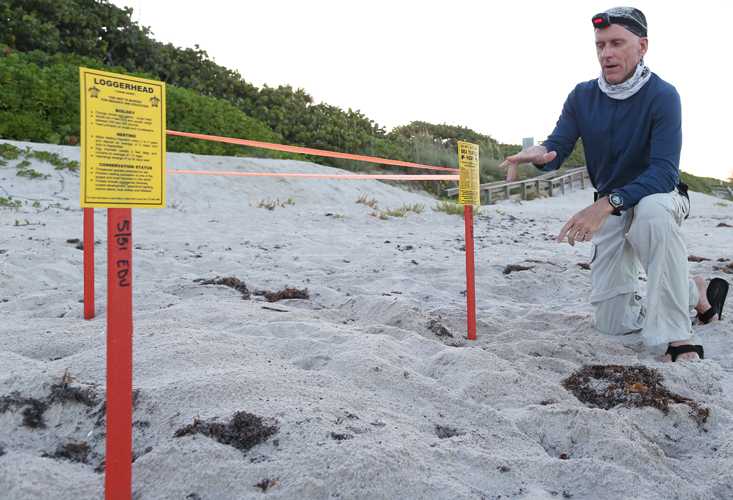
There’s a time and a place for everything, and now just so happens to be the time, and Vero Beach the place, to see loggerhead sea turtles nest on the shore near the ocean.
The Treasure Coast is virtually “sea turtle central,” according to Rick Herren, executive director of Coastal Biology Inc., a local non-profit organization that sponsors walks to observe nature in its finest form – in this case, sea turtles nesting.
Coastal biology leads such walks locally on Friday and Saturday evenings throughout June and July in an effort to educate the community about the sea turtle nesting aspect of the coastal environment.
“There are lots of neat things to see if you live in Ocala or other parts of the state or country. But if you visit here or live here on this part of the coast, we have more sea turtles nesting here than anywhere in the Western Hemisphere,” he said.
The official sea turtle nesting time is March through October, however the peak nesting season is from May through August, and the action occurs along the Florida coast in six counties from Brevard to Broward. Tens of thousands of female sea turtles emerge from the ocean to crawl upon the beach to find an appropriate place to lay their eggs, and they do this multiple times in a season.
Sure anyone can just comb the beach to find sea turtles nesting, but going on a walk led by a biologist permitted by the Florida Fish and Wildlife Conservation Commission is a better way to go given that experts explain the sensitivities of these reptiles as well as their habitat and behaviors, Herren said.
“If mom and pop go out on the beach to find a turtle and spook them, those turtles are going to go back in the water and go somewhere else to nest,” Herren explained.
That’s because when these ocean-going reptiles are on the beach they move slowly and are cumbersome and thus more vulnerable. They are looking for a dark beach with no evidence of predators to dig a cavity in the sand, lay their eggs, cover them up and camouflage the nesting area before leaving their eggs to incubate in the sand as they slip back into the ocean and make their way to another area along the coast to repeat the process. Females drop an average of 110 ping pong ball-size eggs each time they nest which they do roughly five times during a season. It takes about eight weeks for the eggs to incubate.
Sea turtles have a lot of predators and therefore, their nests aren’t always successful. Their eggs are sometimes eaten by raccoons, crabs and coyotes.
Even on a beach with no lights and no predators, the sea turtle might find the shape of the beach isn’t right, or the sand may be too dry or too wet. They are choosey because this is their “parental investment,” Herren adds. They are just trying to place their nest in the most appropriate spot.
There are seven species of sea turtles worldwide. Five species nest in the Florida peninsula. The three most common – all of which are protected, deemed endangered or threatened – are green, loggerhead and leatherback. Loggerheads are a threatened species, not endangered, which is why groups like Herren’s can get permitted by the state to show the public their nesting rituals.
It is estimated that roughly 15,000 to 20,000 female loggerheads nest on the Florida peninsula during the season; 90 percent of these nest on the central and southeast coast from Cape Canaveral to Ft. Lauderdale.
Coastal Biology meets on Friday nights at Indian River Shores Community Center and on Saturday nights at The Moorings Club at 9 p.m. During the first hour, Herren gives a power-point presentation on sea turtle biology and conservation while a couple of scouts comb the beach near those two venues on either night to spot sea turtles nesting.
During the discussion, Herren explains the various species of sea turtles. It is estimated that they live to be about 75 years old. They exist largely in tropical and subtropical areas, and some travel seasonally to northern latitudes. Sea turtles are large, prehistoric and extremely adapted to the ocean environment with their long flippers.
Loggerheads have a brown, orange and yellowish color, and a large head, the size of a basketball. They weigh between 250 and 400 lbs.
Coastal Biology takes groups of 25 people maximum out to the beach after the presentation to view a sea turtle nesting after a scout spots one. Flashlights and flash photography are prohibited as these can spook turtles. Participants are advised to wear light clothing – long-sleeved shirts and long pants since it can be buggy at night – and sturdy walking shoes to be able to walk as far as two-thirds of mile on the beach.
Two things people are most surprised by, Herren says, is the size of these loggerhead sea turtles and watching these giant creatures lay their eggs, cover them up and pack the hole neatly. People are inevitably surprised by how delicate that process is, he said.
If this is her last nesting of the season, she could be going home 2,000 miles away and come back to that same spot to nest a couple of years later.
“It is magical,” said Herren, adding that he got hooked when he saw his first sea turtle nest in 1991 as a surfer. After that, the 7th generation Floridian studied field biology and is currently a full-time biologists for Indian River County. He has worked on the coast the last 23 years, studying sea turtles most of that time, and has led sea turtle walks the last 14 years.
To find out more about the sea turtle walks: www.coastalbiology.org



